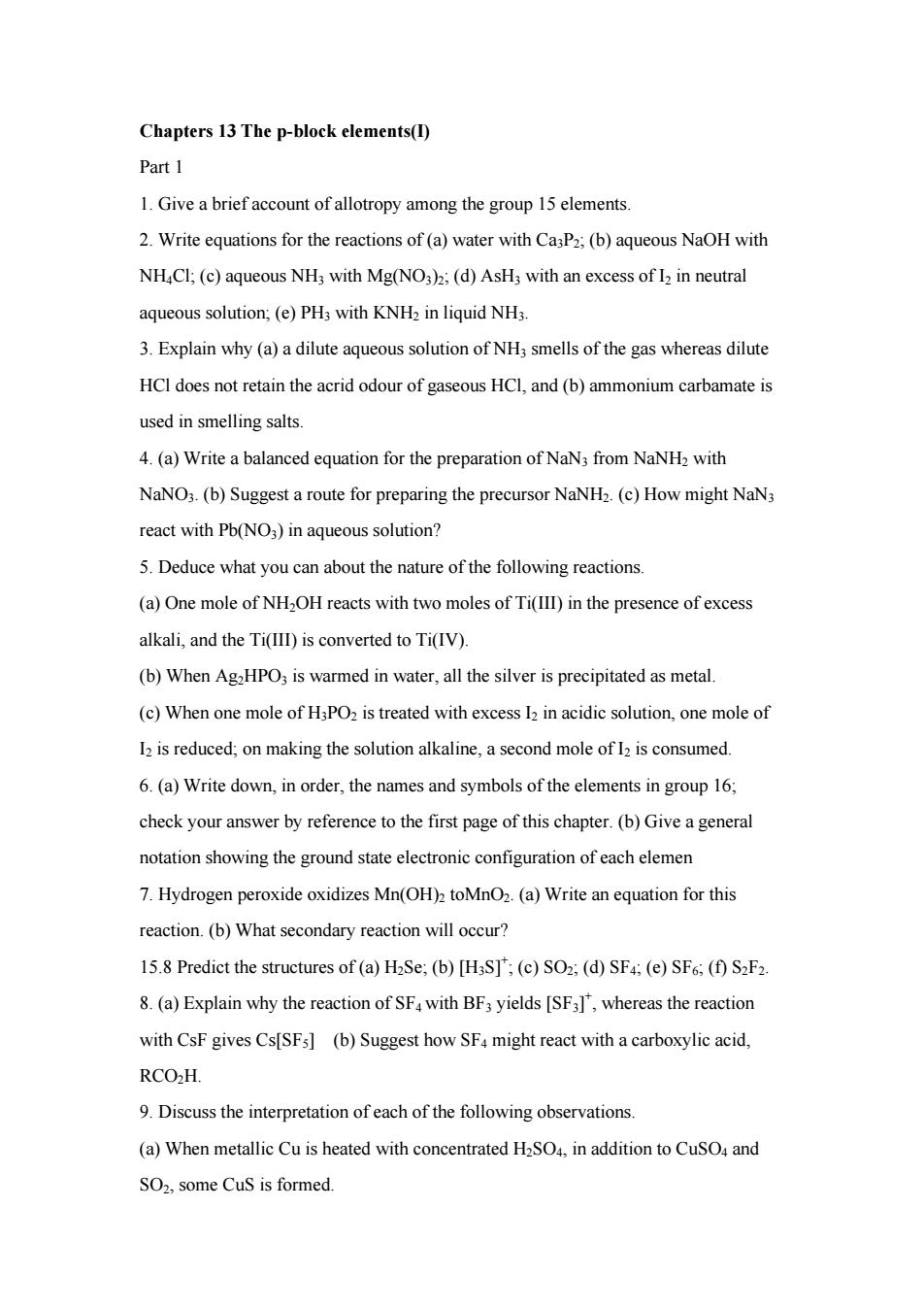
Chapters 13 The p-block elements(I) Part 1 1.Give a brief account of allotropy among the group 15 elements 2.Write equations for the reactions of (a)water with CasP2:(b)aqueous NaOH with NH Cl:(c)aqueous NH3 with Mg(NO3)2;(d)AsH3 with an excess of I2 in neutral aqueous solution;(e)PH3 with KNH2 in liquid NH3. 3.Explain why (a)a dilute aqueous solution of NH3 smells of the gas whereas dilute HCI does not retain the acrid odour of gaseous HCl,and(b)ammonium carbamate is used in smelling salts. 4.(a)Write a balanced equation for the preparation of NaN from NaNH2 with NaNO3.(b)Suggest a route for preparing the precursor NaNH2.(c)How might NaN react with Pb(NO3)in aqueous solution? 5.Deduce what you can about the nature of the following reactions. (a)One mole of NHOH reacts with two moles of Ti(IIl)in the presence of excess alkali,and the Ti(III)is converted to Ti(IV). (b)When Ag2HPO,is warmed in water,all the silver is precipitated as metal. (c)When one mole of H3PO2 is treated with excess I2 in acidic solution,one mole of 12 is reduced;on making the solution alkaline,a second mole of I is consumed 6.(a)Write down,in order,the names and symbols of the elements in group 16; check your answer by reference to the first page of this chapter.(b)Give a general notation showing the ground state electronic configuration of each elemen 7.Hydrogen peroxide oxidizes Mn(OH toMnO2.(a)Write an equation for this reaction.(b)What secondary reaction will occur? 15.8 Predict the structures of (a)H2Se;(b)[H3S];(c)SO2:(d)SF4;(e)SF6:(f)S2F2. 8.(a)Explain why the reaction of SFwith BF3 yields [SF,whereas the reaction with CsF gives Cs[SFs](b)Suggest how SFa might react with a carboxylic acid, RCO2H. 9.Discuss the interpretation of each of the following observations. (a)When metallic Cu is heated with concentrated H2S,in addition to CuSO and SO2,some CuS is formed
Chapters 13 The p-block elements(I) Part 1 1. Give a brief account of allotropy among the group 15 elements. 2. Write equations for the reactions of (a) water with Ca3P2; (b) aqueous NaOH with NH4Cl; (c) aqueous NH3 with Mg(NO3)2; (d) AsH3 with an excess of I2 in neutral aqueous solution; (e) PH3 with KNH2 in liquid NH3. 3. Explain why (a) a dilute aqueous solution of NH3 smells of the gas whereas dilute HCl does not retain the acrid odour of gaseous HCl, and (b) ammonium carbamate is used in smelling salts. 4. (a) Write a balanced equation for the preparation of NaN3 from NaNH2 with NaNO3. (b) Suggest a route for preparing the precursor NaNH2. (c) How might NaN3 react with Pb(NO3) in aqueous solution? 5. Deduce what you can about the nature of the following reactions. (a) One mole of NH2OH reacts with two moles of Ti(III) in the presence of excess alkali, and the Ti(III) is converted to Ti(IV). (b) When Ag2HPO3 is warmed in water, all the silver is precipitated as metal. (c) When one mole of H3PO2 is treated with excess I2 in acidic solution, one mole of I2 is reduced; on making the solution alkaline, a second mole of I2 is consumed. 6. (a) Write down, in order, the names and symbols of the elements in group 16; check your answer by reference to the first page of this chapter. (b) Give a general notation showing the ground state electronic configuration of each elemen 7. Hydrogen peroxide oxidizes Mn(OH)2 toMnO2. (a) Write an equation for this reaction. (b) What secondary reaction will occur? 15.8 Predict the structures of (a) H2Se; (b) [H3S]+ ; (c) SO2; (d) SF4; (e) SF6; (f) S2F2. 8. (a) Explain why the reaction of SF4 with BF3 yields [SF3] + , whereas the reaction with CsF gives Cs[SF5] (b) Suggest how SF4 might react with a carboxylic acid, RCO2H. 9. Discuss the interpretation of each of the following observations. (a) When metallic Cu is heated with concentrated H2SO4, in addition to CuSO4 and SO2, some CuS is formed. 1
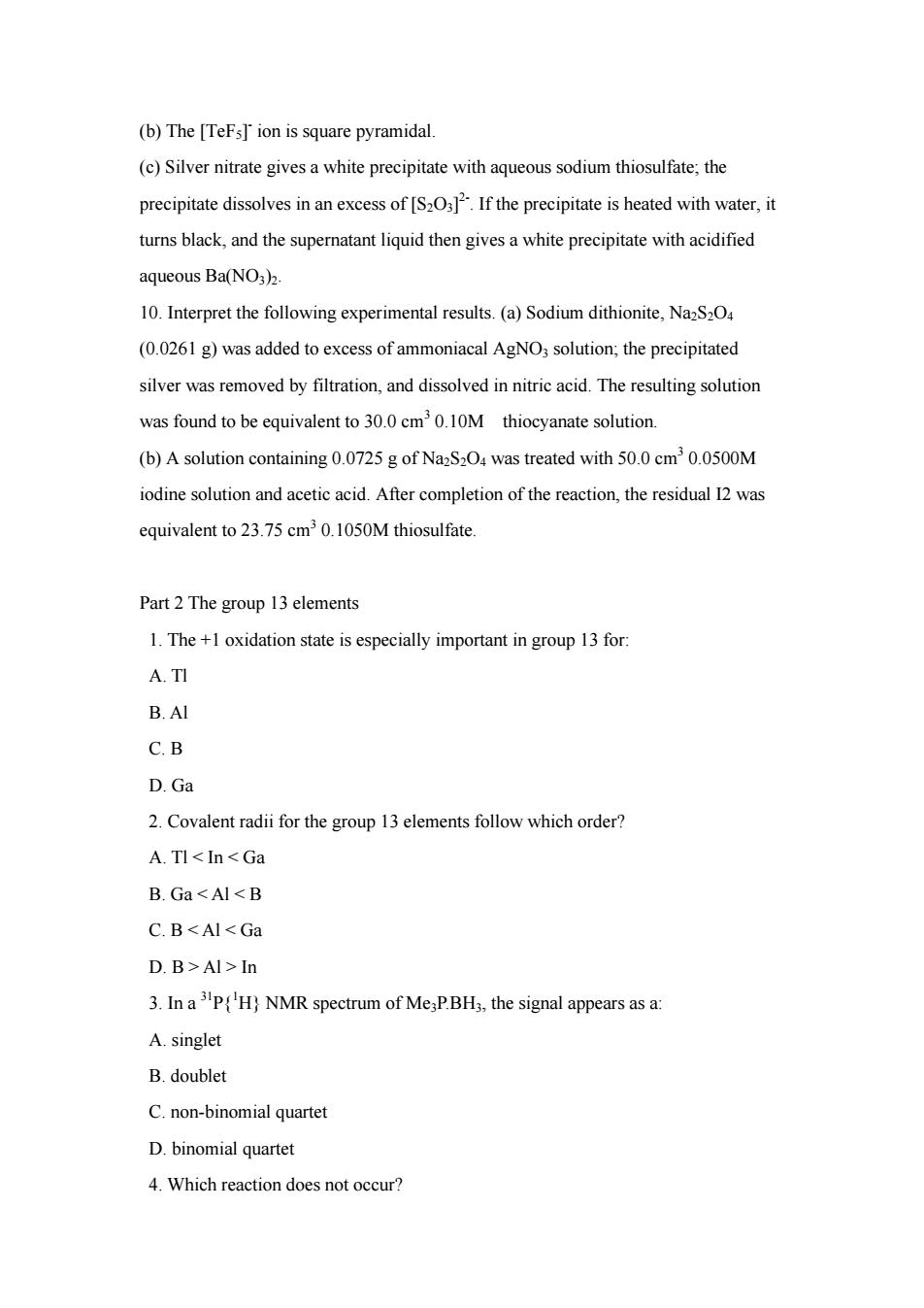
(b)The [TeFs ion is square pyramidal. (c)Silver nitrate gives a white precipitate with aqueous sodium thiosulfate:the precipitate dissolves inanexcess of [SIf the precipitate is heated with water,it turns black,and the supernatant liquid then gives a white precipitate with acidified aqueous Ba(NO3)2. 10.Interpret the following experimental results.(a)Sodium dithionite.NazS (0.0261g)was added to excess of ammoniacal AgNO solution,the precipitated silver was removed by filtration,and dissolved in nitric acid.The resulting solution was found to be equivalent to 30.0 cm20.10M thiocyanate solution. (b)A solution containing 0.0725g of NazS2O was treated with 50.0 cm0.0500M iodine solution and acetic acid.After completion of the reaction,the residual 12 was equivalent to 23.75 cm30.1050M thiosulfate. Part 2 The group 13 elements 1.The+1 oxidation state is especially important in group 13 for A.TI B.Al C.B D.Ga 2.Covalent radii for the group 13 elements follow which order? A.Tl<In<Ga B.Ga<Al<B C.B<Al<Ga D.B>Al>In 3.In spectrum of Me,P.BH3.the signal appears as a A.singlet B.doublet C.non-binomial quartet D.binomial quartet 4.Which reaction does not occur?
(b) The [TeF5] - ion is square pyramidal. (c) Silver nitrate gives a white precipitate with aqueous sodium thiosulfate; the precipitate dissolves in an excess of [S2O3] 2-. If the precipitate is heated with water, it turns black, and the supernatant liquid then gives a white precipitate with acidified aqueous Ba(NO3)2. 10. Interpret the following experimental results. (a) Sodium dithionite, Na2S2O4 (0.0261 g) was added to excess of ammoniacal AgNO3 solution; the precipitated silver was removed by filtration, and dissolved in nitric acid. The resulting solution was found to be equivalent to 30.0 cm3 0.10M thiocyanate solution. (b) A solution containing 0.0725 g of Na2S2O4 was treated with 50.0 cm3 0.0500M iodine solution and acetic acid. After completion of the reaction, the residual I2 was equivalent to 23.75 cm3 0.1050M thiosulfate. Part 2 The group 13 elements 1. The +1 oxidation state is especially important in group 13 for: A. Tl B. Al C. B D. Ga 2. Covalent radii for the group 13 elements follow which order? A. Tl < In < Ga B. Ga < Al < B C. B < Al < Ga D. B > Al > In 3. In a 31P{1 H} NMR spectrum of Me3P.BH3, the signal appears as a: A. singlet B. doublet C. non-binomial quartet D. binomial quartet 4. Which reaction does not occur? 2
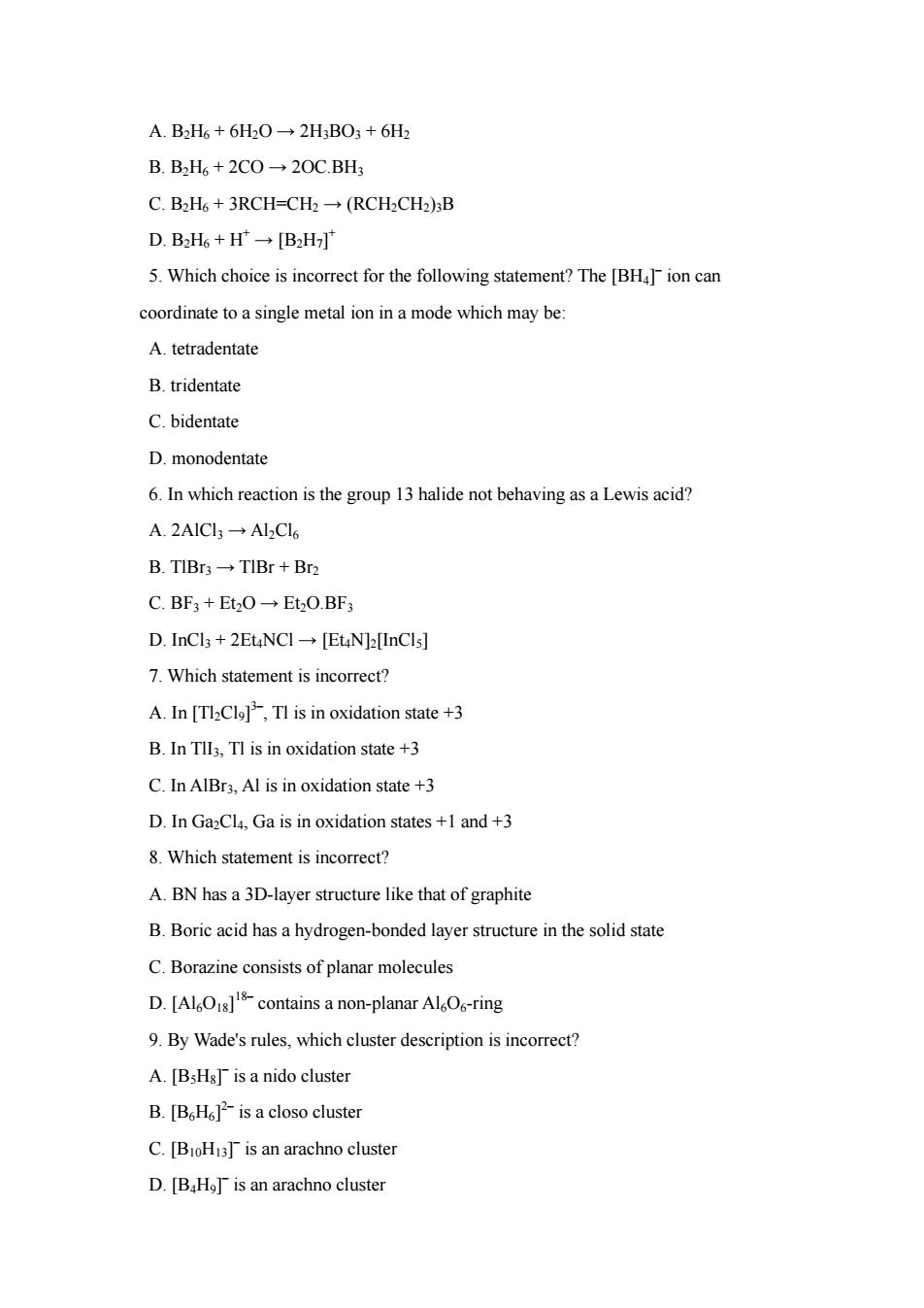
A.B2H6+6H20→2H3B03+6H2 B.B2H6+2C0→2OC.BH3 C.B2H6+3RCH=CH2(RCH2CH2)3B D.BH6+Hf→BH 5.Which choice is incorrect for the following statement?The [BH ion can coordinate to a single metal ion in a mode which may be: A.tetradentate B.tridentate C.bidentate D.monodentate 6.In which reaction is the group 13 halide not behaving as a Lewis acid? A.2AICI3→Al2Cl6 B.TBr3→TIBr+Br2 C.BF3+E0→EtO.BF D.InCls+2Et4NCI[EtN]2[InCls] 7.Which statement is incorrect? A.In [Tl2Clo]-TI is in oxidation state +3 B.InTll3,Tl is in oxidation state+3 C.InAlBr3,Al is in oxidation state+3 D.In Ga2Cl,Ga is in oxidation states+1 and +3 8.Which statement is incorrect? A.BN has a 3D-layer structure like that of graphite B.Boric acid has a hydrogen-bonded layer structure in the solid state C.Borazine consists of planar molecules D.[Al Os]contains a non-planar AlO-ring 9.By Wade's rules,which cluster description is incorrect? A.[BsHsT is a nido cluster B.[BH612-is a closo cluster C.[an arachno cluster D.[BH]is an arachno cluster
A. BB 2H6 + 6H2O → 2H3BO3 + 6H2 B. BB 2H6 + 2CO → 2OC.BH3 C. BB 2H6 + 3RCH=CH2 → (RCH2CH2)3B D. BB 2H6 + H → [B + 2H7] + 5. Which choice is incorrect for the following statement? The [BH4] – ion can coordinate to a single metal ion in a mode which may be: A. tetradentate B. tridentate C. bidentate D. monodentate 6. In which reaction is the group 13 halide not behaving as a Lewis acid? A. 2AlCl3 → Al2Cl6 B. TlBr3 → TlBr + Br2 C. BF3 + Et2O → Et2O.BF3 D. InCl3 + 2Et4NCl → [Et4N]2[InCl5] 7. Which statement is incorrect? A. In [Tl2Cl9] 3–, Tl is in oxidation state +3 B. In TlI3, Tl is in oxidation state +3 C. In AlBr3, Al is in oxidation state +3 D. In Ga2Cl4, Ga is in oxidation states +1 and +3 8. Which statement is incorrect? A. BN has a 3D-layer structure like that of graphite B. Boric acid has a hydrogen-bonded layer structure in the solid state C. Borazine consists of planar molecules D. [Al6O18] 18– contains a non-planar Al6O6-ring 9. By Wade's rules, which cluster description is incorrect? A. [B5H8] – is a nido cluster B. [B6H6] 2– is a closo cluster C. [B10H13] – is an arachno cluster D. [B4H9] – is an arachno cluster 3
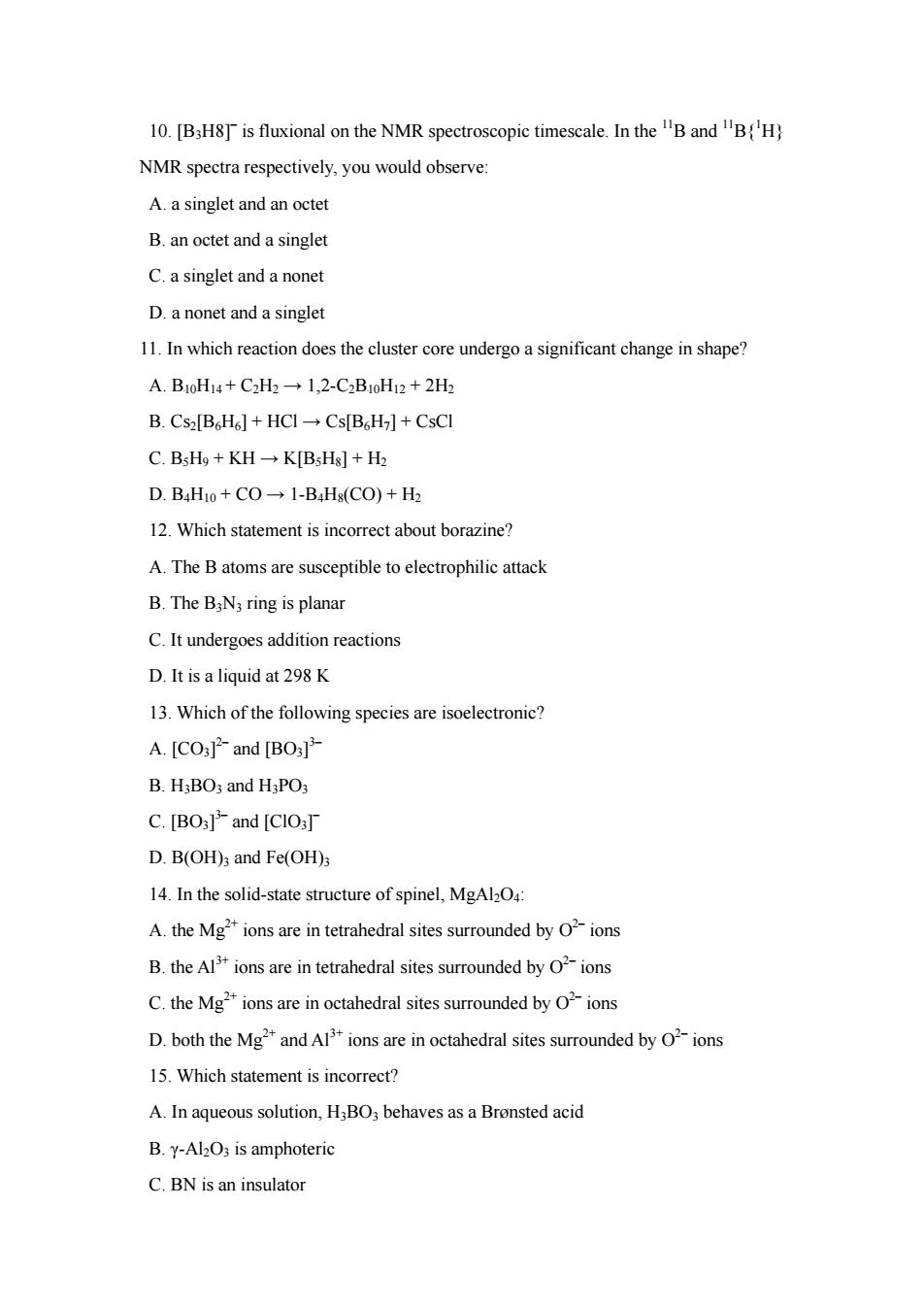
10.[BH8 is fluxional on the NMR spectroscopic timescale.In theB andBH NMR spectra respectively,you would observe: A.asinglet and an octet B.an octet and a singlet C.a singlet and a nonet D.a nonet and a singlet 11.In which reaction does the cluster core undergo a significant change in shape? A.BIoH4+C2H21,2-C2BIoHi2+2H2 B.CsB6H6l+HCI一→CsB6H]+CsCI C.B+KH→KBH图+H D.BaHio+CO-1-BaHs(CO)+Hz 12.Which statement is incorrect about borazine? A.The B atoms are susceptible to electrophilic attack B.The B:N3 ring is planar C.It undergoes addition reactions D.It is a liquid at 298 K 13.Which of the following species are isoelectronic? A.[CO3-and [BO3] B.H3BO3 and H3PO3 C.[BO3]and [CIO3 D.B(OH)and Fe(OH) 14.In the solid-state structure of spinel,MgAl2O: A.the Mgions are in tetrahedral sites surrounded by -ions B.the Alions are in tetrahedral sites surrounded by O2-ions C.the Mgions are in octahedral sites surrounded by -ions D.both the Mg2and Alions are in octahedral sites surrounded by O2-ions 15.Which statement is incorrect? A.In aqueous solution,H3BO3 behaves as a Bronsted acid B.Y-Al2O3 is amphoteric C.BN is an insulator
10. [B3H8]– is fluxional on the NMR spectroscopic timescale. In the 11B and 11B{1 H} NMR spectra respectively, you would observe: A. a singlet and an octet B. an octet and a singlet C. a singlet and a nonet D. a nonet and a singlet 11. In which reaction does the cluster core undergo a significant change in shape? A. BB 10H14 + C2H2 → 1,2-C2B10B H12 + 2H2 B. Cs2[B6H6] + HCl → Cs[B6H7] + CsCl C. BB 5H9 + KH → K[B5B H8] + H2 D. BB 4H10 + CO → 1-B4H8(CO) + H2 12. Which statement is incorrect about borazine? A. The B atoms are susceptible to electrophilic attack B. The BB 3N3 ring is planar C. It undergoes addition reactions D. It is a liquid at 298 K 13. Which of the following species are isoelectronic? A. [CO3] 2– and [BO3] 3– B. H3BO3 and H3PO3 C. [BO3] 3– and [ClO3] – D. B(OH)3 and Fe(OH)3 14. In the solid-state structure of spinel, MgAl2O4: A. the Mg2+ ions are in tetrahedral sites surrounded by O2– ions B. the Al3+ ions are in tetrahedral sites surrounded by O2– ions C. the Mg2+ ions are in octahedral sites surrounded by O2– ions D. both the Mg2+ and Al3+ ions are in octahedral sites surrounded by O2– ions 15. Which statement is incorrect? A. In aqueous solution, H3BO3 behaves as a Brønsted acid B. γ-Al2O3 is amphoteric C. BN is an insulator 4
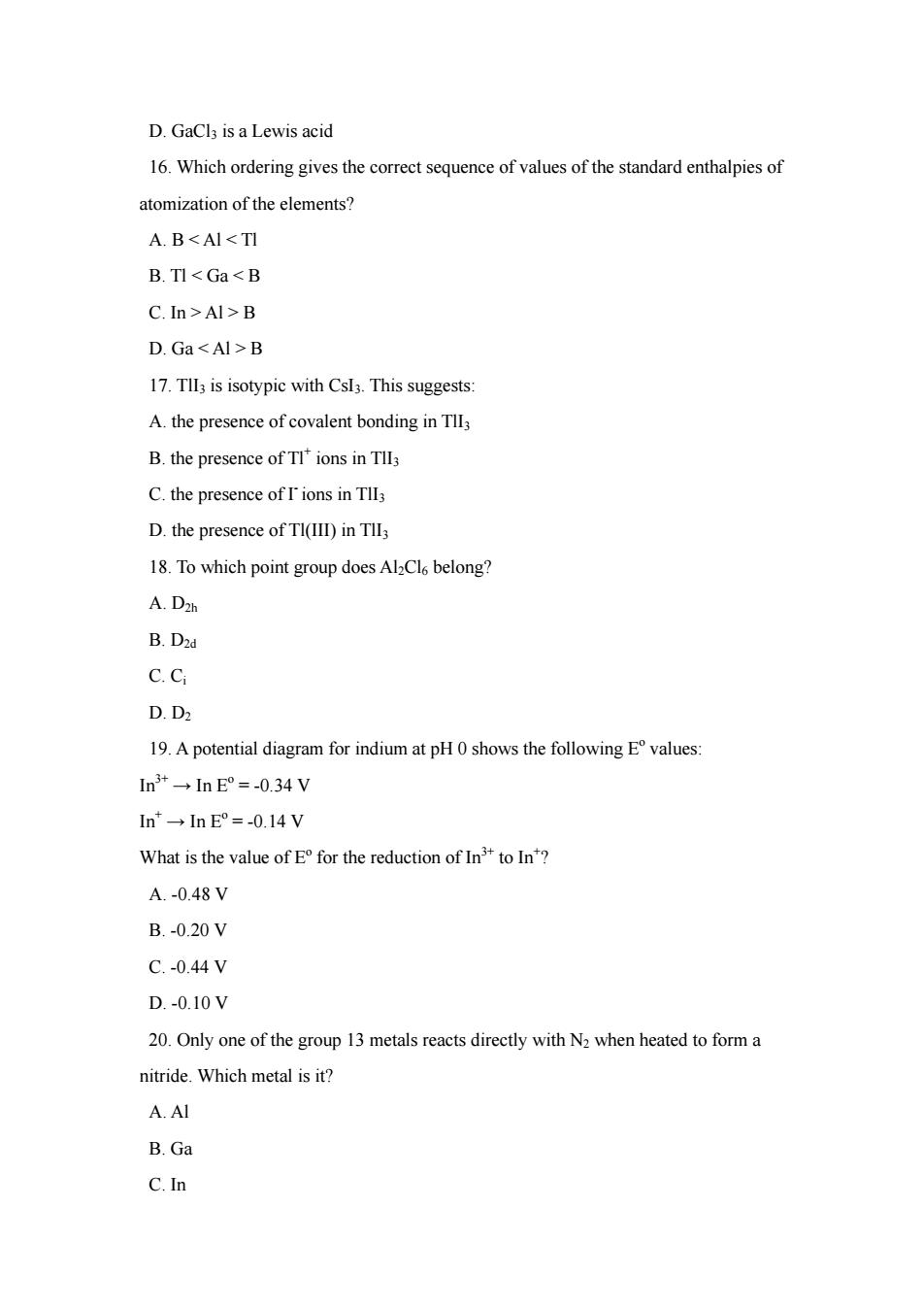
D.GaCla isa Lewis acid 16.Which ordering gives the correct sequence of values of the standard enthalpies of atomization of the elements? A.B<AI<TI B.Tl<Ga<B C.In>Al>B D.Ga<Al>B 17.T,is isotypic with Csl.This suggests A.the presence of covalent bonding in Tl3 B.the presence ofTl'ions inTl3 C.the presence ofions inTll D.the presence ofTI(II)inTl 18.To which point group does Al2Cl belong? A.D2h B.D2d C.C D.D2 19.A potential diagram for indium at pHshows the following E values In→nE°=-0.34V ln→InE°=-0.14V What is the value of E for the reduction of In3+to In'? A.-0.48V B.-0.20V C.-0.44V D.-0.10V 20.Only one of the group 13 metals reacts directly with N2 when heated to form a nitride.Which metal is it? A.Al B.Ga C.In
D. GaCl3 is a Lewis acid 16. Which ordering gives the correct sequence of values of the standard enthalpies of atomization of the elements? A. B < Al < Tl B. Tl < Ga < B C. In > Al > B D. Ga < Al > B 17. TlI3 is isotypic with CsI3. This suggests: A. the presence of covalent bonding in TlI3 B. the presence of Tl+ ions in TlI3 C. the presence of I- ions in TlI3 D. the presence of Tl(III) in TlI3 18. To which point group does Al2Cl6 belong? A. D2h B. D2d C. Ci D. D2 19. A potential diagram for indium at pH 0 shows the following Eo values: In3+ → In Eo = -0.34 V In+ → In Eo = -0.14 V What is the value of Eo for the reduction of In3+ to In+ ? A. -0.48 V B. -0.20 V C. -0.44 V D. -0.10 V 20. Only one of the group 13 metals reacts directly with N2 when heated to form a nitride. Which metal is it? A. Al B. Ga C. In 5